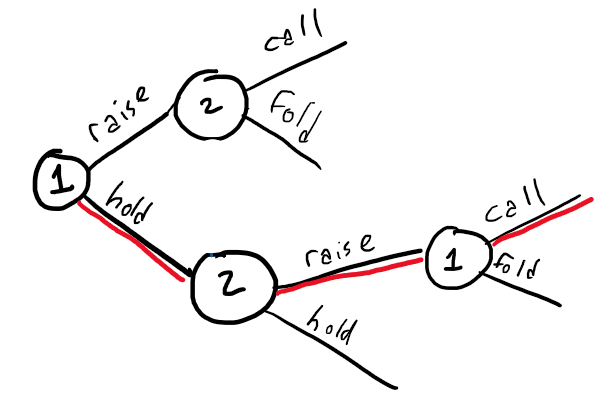what game are we playing
Authors
Yuxin Wang, Evan Peters, Yifan Mou, Sangeeth Kalaichanthiran
Introduction
Quantal response in Normal form games
Learning Extensive form games
The normal form representation for games where players have _many_ choices quickly becomes intractable. For example, consider a chess game: One the first turn, player 1 has 20 possible moves and then player 2 has 20 possible responses. If in the following number of turns each player is estimated to have ~30 possible moves and if a typical game is 40 moves per player, the total number of strategies is roughly [math]\displaystyle{ 10^{120} }[/math] per player (this is known as the Shannon number for game-tree complexity of chess) and so the payoff matrix for a typical game of chess must therefore have [math]\displaystyle{ O(10^{240}) }[/math] entries.
Instead, it is much more useful to represent the game graphically (in "Extensive form"). We'll also need to consider types of games where there is incomplete information - players do not necessarily have access to the full state of the game. An example of this is one-card poker: (1) Each player draws a single card from a 13-card deck (ignore suits) (2) Player 1 decides whether to bet/hold (3) Player 2 decides whether to call/raise (4) Player 1 must either call/fold if Player 2 raised. From this description, player 1 has [math]\displaystyle{ 2^{13} }[/math] possible first moves (all combinations of (card, raise/hold)) and has [math]\displaystyle{ 2^{13} }[/math] possible second moves (whenever player 1 gets a second move) for a total of [math]\displaystyle{ 2^{26} }[/math] possible strategies. In addition, Player 1 never knows what cards player 2 has and vice versa. So instead of representing the game with a huge payoff matrix we can instead represent it as a simple decision tree:

where player 1 is represented by "1", a node that has two branches corresponding to the allowed moves of player 1. However there must also be a notion of information available to either player; player 1 does not know what card player 2 has, and so player 2's decisions